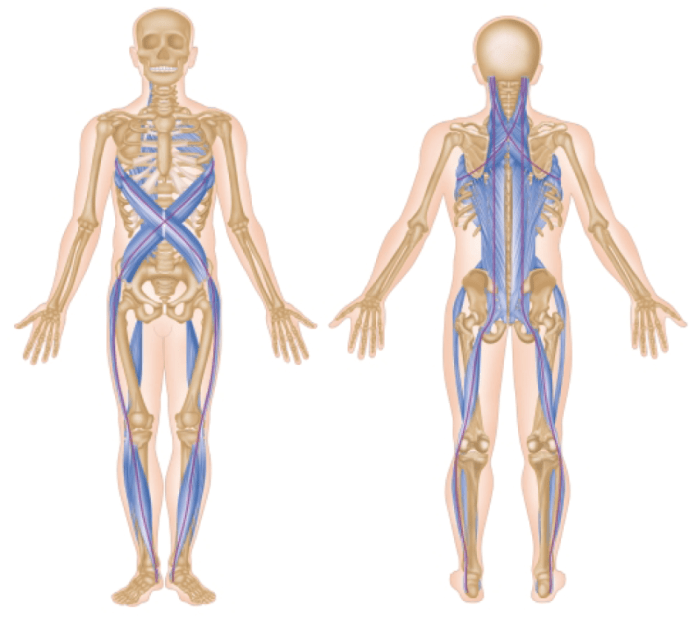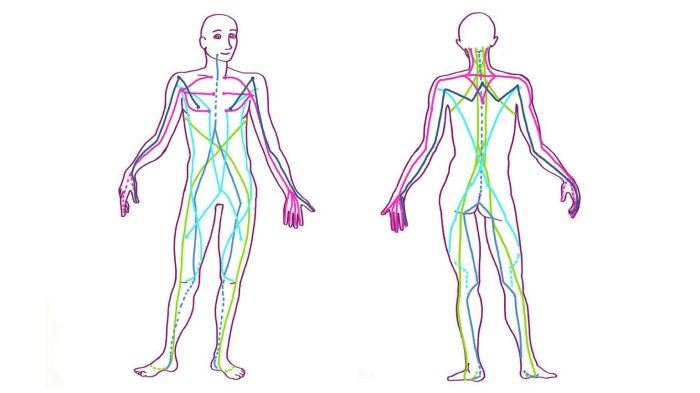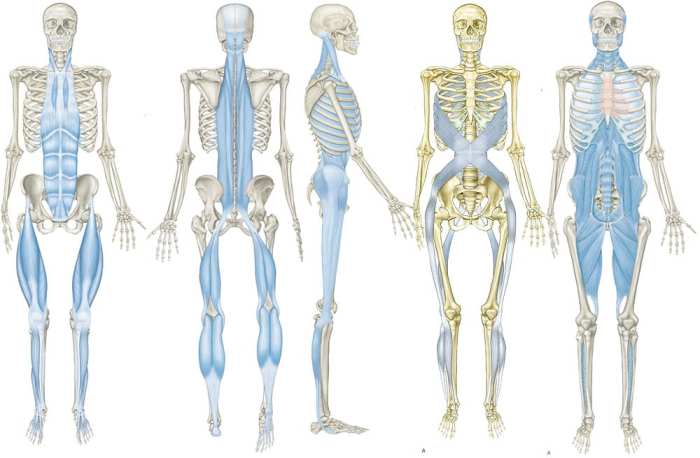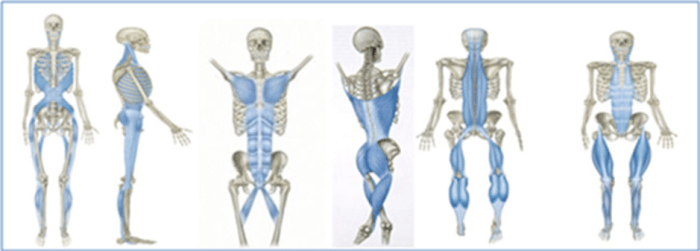Fascial lines of the body, the intricate network of connective tissue that weaves through our physical form, are the unsung heroes of human movement and well-being. From head to toe, these lines shape our posture, support our organs, and facilitate seamless communication between different parts of our body.
Join us on a captivating journey as we unravel the mysteries of fascial lines, revealing their anatomy, functions, and profound clinical significance.
The fascial lines of the body, a symphony of connective tissue, orchestrate a harmonious interplay between our muscles, bones, and organs. These lines, like invisible threads, transmit forces throughout our body, allowing us to move with grace and ease. They serve as pathways for fluids, nutrients, and sensory signals, ensuring optimal functioning of our tissues.
Fascial Lines

Fascial lines are interconnected pathways of connective tissue that run throughout the body. They provide structural support, transmit force, and play a role in movement and posture.
There are three main types of fascial lines: superficial, deep, and intramuscular.
Superficial Fascial Lines
Superficial fascial lines are located just beneath the skin. They are composed of loose connective tissue and contain blood vessels, nerves, and lymphatics.
Deep Fascial Lines
Deep fascial lines are located deeper in the body, between muscles and other structures. They are composed of dense connective tissue and provide structural support and protection.
Intramuscular Fascial Lines
Intramuscular fascial lines are located within muscles. They divide the muscle into compartments and help to transmit force.
Anatomy of Fascial Lines

Fascial lines are interconnected, three-dimensional bands of connective tissue that traverse the body, providing structural support and organization. They are located within the superficial fascia, deep fascia, and intramuscular fascia layers.
Superficial Fascial Lines
The superficial fascial lines are located beneath the skin and are composed of loose connective tissue. They are most prominent in areas with high mobility, such as the neck, axilla, and groin.
- Platysma lines:Extend from the mandible to the clavicle and acromion process, forming a Y-shaped pattern.
- Langer’s lines:Follow the direction of skin tension and are visible when the skin is stretched.
- Cleavage lines:Indicate the direction of least skin tension and are used for surgical incisions.
Deep Fascial Lines
The deep fascial lines are located beneath the superficial fascia and are composed of dense connective tissue. They surround and separate muscles, providing support and preventing friction.
- Thoracolumbar fascia:Extends from the thoracic vertebrae to the lumbar vertebrae, forming a thick, fibrous sheet that separates the thoracic and abdominal cavities.
- Iliolumbar fascia:Connects the ilium to the lumbar vertebrae, forming a strong band that supports the lower back.
- Gluteal fascia:Encloses the gluteal muscles, providing support and preventing excessive movement.
Intramuscular Fascial Lines
The intramuscular fascial lines are located within muscles and are composed of connective tissue that surrounds and separates muscle fibers. They provide support and facilitate muscle contraction.
- Perimysium:Surrounds individual muscle fibers.
- Endomysium:Surrounds bundles of muscle fibers (fascicles).
- Epimysium:Surrounds the entire muscle.
Function of Fascial Lines

Fascial lines are not merely passive structures; they play crucial roles in various physiological processes.
These roles include providing support and stability, transmitting force, facilitating fluid transport, and contributing to sensory perception.
Fascial lines are lines of connective tissue that run throughout the body, and they play a role in posture, movement, and pain. If you’ve ever read the girl and the chenoo , you know that fascial lines can also be used to tell stories.
The story of the girl and the chenoo is a beautiful example of how fascial lines can connect us to our past, present, and future.
Support and Stability
Fascial lines form a dense network that provides support and stability to the body. They act as a scaffolding system, helping to maintain the shape and integrity of the body’s structures.
Transmission of Force
Fascial lines transmit forces throughout the body. When a muscle contracts, it pulls on the fascial lines that surround it, transmitting the force to other parts of the body. This allows for coordinated movement and efficient force transfer.
Fluid Transport
Fascial lines play a role in fluid transport. They contain channels and pathways that allow for the movement of fluids, including blood, lymph, and interstitial fluid. This facilitates nutrient delivery, waste removal, and immune function.
Sensory Perception
Fascial lines contain sensory receptors that contribute to sensory perception. These receptors can detect changes in pressure, temperature, and movement, providing the body with information about its environment.
Clinical Significance of Fascial Lines

Fascial lines are of great clinical significance, as they play a crucial role in various aspects of human health and movement.
Their clinical implications can be categorized into three main areas:
Pain and Dysfunction, Fascial lines of the body
Fascial lines can contribute to pain and dysfunction in several ways:
- Trigger points:Fascial lines can develop trigger points, which are hypersensitive areas that can cause pain when pressure is applied.
- Muscle imbalances:Fascial lines can restrict or facilitate muscle movement, leading to muscle imbalances and pain.
- Nerve entrapment:Fascial lines can compress nerves, causing pain, numbness, and weakness.
Surgical Approaches
Fascial lines are considered during surgical procedures, as they provide important landmarks and pathways:
- Surgical incisions:Surgeons often make incisions along fascial lines to minimize damage to surrounding tissues.
- Fascial release:In some cases, surgeons may release fascial lines to relieve pain or improve mobility.
Rehabilitation Strategies
Fascial lines are also relevant in rehabilitation:
- Stretching and massage:Stretching and massage techniques can help release tension in fascial lines, improving flexibility and reducing pain.
- Strengthening exercises:Strengthening exercises can help improve muscle balance and reduce the risk of fascial strain.
- Movement retraining:Fascial lines can be retrained through specific exercises to improve movement patterns and reduce pain.
Research and Future Directions

Research on fascial lines is a growing field, with many promising directions for future investigation.
One area of interest is the role of fascial lines in injury and rehabilitation. Fascial lines have been shown to play a role in the transmission of force and movement throughout the body, and disruptions to these lines can lead to pain and dysfunction.
Research is currently underway to investigate how fascial lines can be rehabilitated after injury, and how this can improve patient outcomes.
Potential Future Directions
- The use of fascial lines as a diagnostic tool for musculoskeletal disorders.
- The development of new treatment techniques that target fascial lines.
- The investigation of the role of fascial lines in chronic pain conditions.
- The exploration of the potential of fascial lines to enhance athletic performance.
FAQ Summary: Fascial Lines Of The Body
What exactly are fascial lines?
Fascial lines are continuous bands of connective tissue that envelop and connect various structures within the body, creating a three-dimensional web that supports and coordinates movement.
How do fascial lines contribute to movement?
Fascial lines transmit forces generated by muscles, allowing for efficient and coordinated movement. They also provide stability and support to joints and other structures.
Can fascial lines be damaged?
Yes, fascial lines can be damaged through injuries, repetitive motions, or poor posture. This damage can lead to pain, stiffness, and reduced mobility.